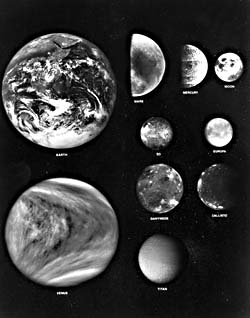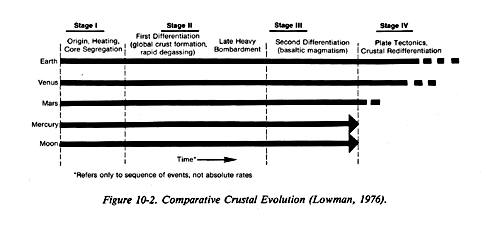| Figure 10.1. Photographic montage illustrating relative sizes of planets and satellites (Meszaros, 1983). |  |
|---|
With the achievement of space flight, geomorphology suddenly expanded its scope by orders of magnitude. As recently as the early 1960s, geomorphologists could study one planet directly and one satellite telescopically and could speculate on the dimly seen surface of Mars. Twenty-five years later, they are studying landforms on some 21 planetary bodies besides the Earth, ranging from Earth-sized Venus to the asteroid-sized satellites of Mars (which may in fact be captured asteroids). This chapter presents a small sample of these landforms, beginning with this introduction and summarizing the main factors that affect geomorphic evolution throughout the solar system. This summary draws heavily on reviews of planetary (extraterrestrial) geomorphology by Sharp (1974), Baker (1983), and Greeley (1985), in which the reader will find useful background material. The relative sizes of bodies covered in this chapter are illustrated in Figure 10-1; a useful summary of numerical data is presented by Beatty et al. (1982).
Mass
The most basic property of any body, its mass, is perhaps the leading single factor governing its geomorphology. Mass of a planetary body controls several other factors that are themselves critical, a major one being the retention or loss of atmosphere, which depends strongly on a planet's gravity field. It should be pointed out here (with the aid of Figure 10-2) that, for the inner planets, the general stage of crustal evolution reached is a strong function of mass. The Moon, smallest of the bodies tabulated, is the least-evolved and the least-active now, in contrast to the largest body shown, the Earth. With the notable exception of the volcanically active Galilean satellite, Io, which is continually heated by tidal friction, the dependence of tectonic and, to a large extent geomorphic, evolution on mass holds throughout the solar system, subject to other considerations that will be covered separately.
Location
The location of a planetary body with respect to its primary is another dominant factor in its evolution. The most obvious illustration is the great difference in composition between the inner and outer planets, which can be loosely grouped as silicate and hydrogen planets (Lowman, 1976). The reason for this compositional dichotomy is primarily the temperature gradient in the primordial solar nebula, as shown by Lewis (1974). Another example is furnished by the Galilean satellites of Jupiter, which display a similar compositional variation. The innermost satellite, Io, is clearly a silicate body, judging from its density, while the outermost satellite, Callisto, must be largely ice. Pollack and Reynolds (1974) have suggested that these satellites, while accreting, were influenced by heat from Jupiter, which is within two orders of magnitude of being massive enough to sustain thermonuclear reactions.
Composition
The bulk composition of the bodies described here ranges from largely iron and Fe-Mg silicates (Mercury) to almost pure water ice (the Saturnian satellites). The small satellites of Mars, Phobos and Deimos, appear to consist of carbonaceous chondrite material. In the Earth/Moon binary planet system, the Moon is systematically low in volatiles compared to the Earth, and lunar rocks have been found to be almost completely water free. More subtle compositional differences among planets, such as radioactive element content, have probably had major effects on their geologic evolution. From a geomorphic viewpoint, the difference in water content is probably the most important factor governing landform development in the silicate planets, as we will see when discussing comparative geomorphology of Mars, the Moon, and Mercury.
Atmosphere
Closely related to water content in geomorphic importance is the presence or absence of an atmosphere, and on the bodies with atmospheres, the pressure, temperature, and composition of each atmosphere. Here too, the range in properties is startling. Venus has a carbon dioxide atmosphere, clouds of what appears to be sulfuric acid, and surface pressure on the order of 90 bars, while the Moon has so little atmosphere that the hydrogen nuclei of the solar wind reach the lunar surface directly. Mars has only a thin carbon dioxide atmosphere today, the highest surface pressures being less than 10 millibars, yet there is ample evidence of a much denser atmosphere in the past. Even now, the thin Martian atmosphere can sustain dust storms and major eolian erosion. The atmosphere of Titan, the only satellite that has one, appears to consist mainly of methane, so cold that there may be pools of liquid methane on the surface. The landforms of this surface, invisible through the opaque atmosphere, must be unimaginably alien.
| Figure 10.1. Photographic montage illustrating relative sizes of planets and satellites (Meszaros, 1983). |  |
|---|
Surface Temperature
Terrestrial geomorphology is greatly influenced, both directly and indirectly, by temperature. Temperatures encountered on the surfaces of planets and satellites discussed here cover a range of several hundred degrees Celsius. On Mercury, lead would melt in the daytime, whereas on Titan, the surface temperature is less than 100°K, close to the triple point of methane. Even on Mars, the temperature now rarely if ever gets above the freezing point of water, but in the past, near-surface temperatures have locally and temporarily permitted extensive melting of ground ice. Temperatures on the surface of Venus, Earth´s near-twin in size, are around 450°C, high enough to affect the geothermal gradient and perhaps the nature of rock deformation. The extreme temperatures on Earth-like planets have undoubtedly had fundamental direct and indirect influence on the nature of planetary landforms, far more than we now realize.
Surface Gravity
The force of gravity at a planet´s surface, a direct function of mass, has indirect geomorphic effects by governing the retention of an atmosphere and the surface pressure where one is present. By controlling internal pressure gradients, planetary gravity also affects geophysical phenomena such as magma generation and isostatic adjustment (although temperature is equally important). However, there can be many direct effects on geomorphic evolution from differences in surface gravity. On very small bodies, such as the ice satellites of Saturn, impact craters do not display the ejecta blankets typical of such craters on the Moon or Mars, probably because the ejecta spreads over extremely large areas. For the smallest bodies, such as Phobos and Deimos, escape velocity is so low (a few meters per second) that most impact ejecta is blown completely off, and may not return. Even on Io, larger than the Moon, escape velocity is so low that some of the material erupted from volcanoes goes into space, forming a torus around Jupiter. Geomorphologists studying extraterrestrial bodies must therefore keep in mind the fact that landscape evolution elsewhere may occur in far weaker gravitational fields than that of the Earth.
| Figure 10.2. Comparative Crustal Evolution (Lowman, 1976). |
|---|
 |
Although all the bodies in the solar system probably formed at about the same time (4.6 billion years ago), they have evolved geologically and geomorphically at drastically differing rates. Perhaps the most important generalization about planetary time scales is that many of these bodies remain in a very primitive stage of crustal evolution (Figure 10-2), corresponding to the earliest Archean on Earth. This is illustrated by the fact that the very first basalts collected on the Moon by the Apollo 11 crew turned out to be 3.6 billion years old, nearly as old as the oldest known rocks anywhere on Earth. An even more dramatic illustration of the primitive state of the lunar surface comes from exposure ages of lunar samples (French, 1977), many of which are in the 100 million year range; sample 10017 had been lying on the surface in the same position for about 3 million years when it was picked up. Things happen much more rapidly on Mars, judging from terrain ages indicated by crater populations, but even Martian landforms are probably hundreds of millions or billions of years old. On the basis of Venera radar imagery (Lowman et al., 1985), it has been proposed that the present surface of Venus is similar to that of the Canadian Shield in the Proterozoic, when eruptions from what are now dike swarms produced huge floods of basalt. Extraterrestrial landforms, then, may represent features and stages of crustal evolution for which there is little or no evidence surviving on Earth; they are indeed fossil landscapes.
The foregoing comments on time scales should be qualified with two specific exceptions. Until 1979, it was believed that the Earth was the most geologically active solid body in the solar system, but in that year, the Voyager spacecraft returned the electrifying pictures showing nine erupting volcanoes on Io. These volcanoes are resurfacing the Ionian landscape while we watch, and it now takes title for the youngest land surface in the solar system. Reasons for this are discussed in the text for Plate P-13. Another exception to the great age of planetary landscapes may be Venus. Soviet Venera radar imagery has revealed only a small number of resolvable impact craters (on the order of 100 to 150), implying a geomorphic age roughly comparable to that of the Earth. The proposed similarity of Venusian topography to the Proterozoic Canadian Shield does not contradict this low age: Venus has apparently not undergone extensive fluvial erosion, while the Earth of course has. Landforms and rock types (chiefly tectonic and volcanic) preserved on Venus are thus considered to be similar to those long destroyed on Earth.
It is appropriate to close this introduction on a cautionary note. There will be a natural tendency for geomorphologists to look for terrestrial analogs in the photographs of extraterrestrial landscapes presented here. There are of course many obvious analogs: the huge volcanoes of Mars are outsize replicas of those in Hawaii, landslides of the Valles Marineris can be matched by those in poorly engineered road cuts, and small lunar craters resemble craters formed by falling rockets. But it is almost certain that some, perhaps many, of the landforms found on other planets are unique to those planets, or at least have no terrestrial counterparts. Geomorphologists will do well to remember J. D. Bernal´s aphorism: "The universe is not only stranger than we imagine, it is stranger than we can imagine."
Continue to Plate P-1| Chapter 9 Table of Contents.| Return to Home Page| Complete Table of Contents|